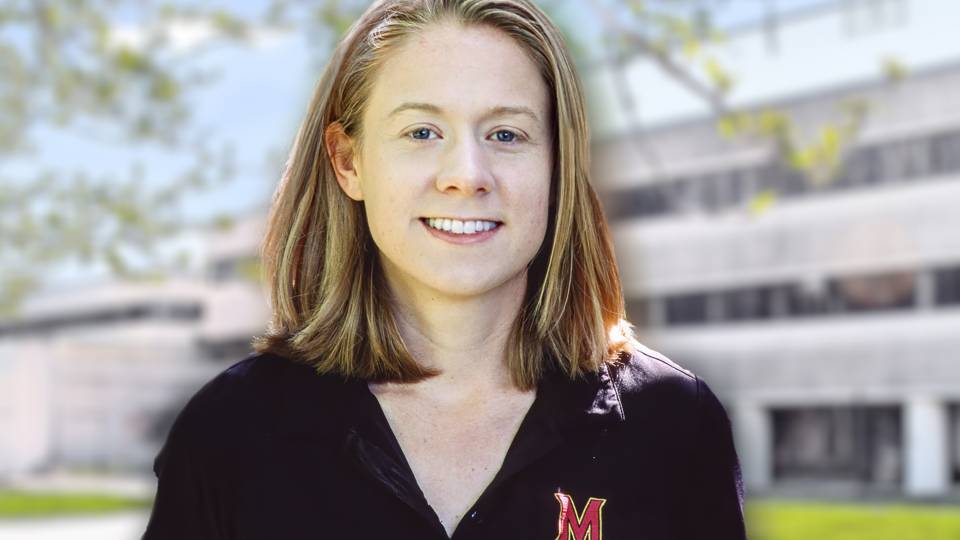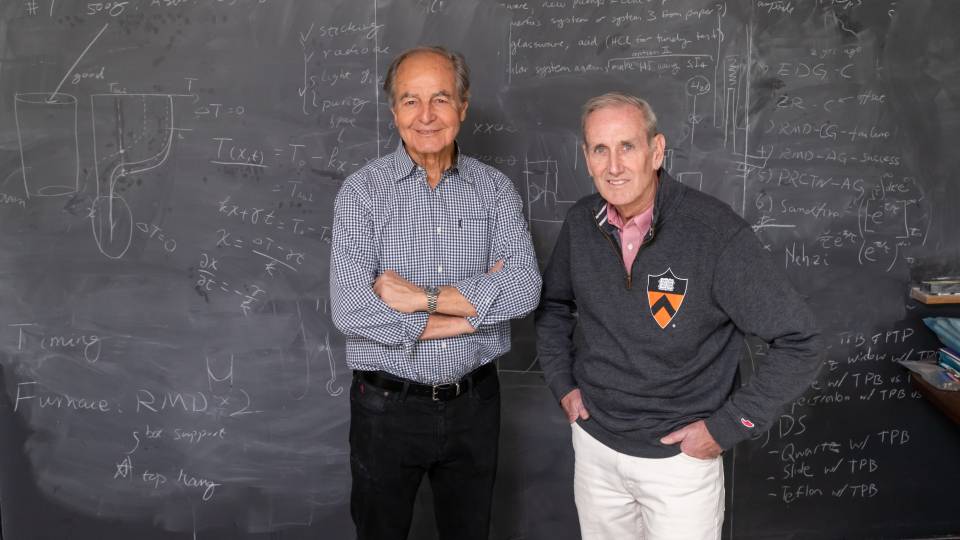Mention fusion energy, and people around here will think of the breakthroughs happening at the Princeton Plasma Physics Laboratory (PPPL) in fusing — combining — the nuclei of hydrogen isotopes. But there are other kinds of fusion power, including one long shot that just got a big boost from the Department of Energy’s Advanced Research Projects Agency-Energy (ARPA-E).

Nat Fisch (second left) and his research team are pursuing proton-boron11 fusion, which Fisch calls 'the holy grail of really clean, really abundant fusion energy.' Fisch’s team includes two postdocs, Ian Ochs (right) and Elijah Kolmes (center), both 2022 Ph.D. alumni of Princeton, and two graduate students, Mikhail Mlodik (second right) and Tal Rubin (left).
The audacious research project is investigating the “holy grail” of clean fusion energy, said Nat Fisch, a professor of astrophysical sciences at Princeton University and the principal investigator of the new project. Unlike the deuterium-tritium (DT) fusion pursued for decades, he and his team want to exploit the fusion reaction of a proton with a boron-11 ion (pB11).
“Of course, the easiest fusion reaction by far is DT,” said Fisch, who is also the director of the Program in Plasma Physics at the University and the associate director for academic affairs at PPPL. “It is difficult enough, but still the most sensible approach to pursue, and I was taught in graduate school that the pB11 reaction cannot be practical. Yet pB11 is the holy grail of really clean, really abundant fusion energy.”
Emily Carter, who was recently named the senior strategic advisor for sustainability science at PPPL, said: “Fusion power has the potential to provide stable electricity to power the world without the intermittency and land requirements of solar and wind farms, and it therefore is worth our investment.” Carter is also Princeton’s Gerhard R. Andlinger Professor in Energy and the Environment as well as a professor of mechanical and aerospace engineering, the Andlinger Center for Energy and the Environment, and applied and computational mathematics.
Fisch recently got word that his team would receive $1.5 million from the ARPA-E OPEN 2021 program, which prioritizes funding technologies that support novel approaches to clean energy challenges.
In announcing the selected ARPA-E projects, U.S. Secretary of Energy Jennifer Granholm said, “Universities, companies and our national labs are doubling down on advancing clean energy technology innovation and manufacturing in America to deliver critical energy solutions from renewables to fusion energy to tackle the climate crisis.”
There is enormous energy available in transforming elements: in the case of nuclear fission by splitting heavy nuclei, in the case of fusion by combining light nuclei, a nuclear reaction that does not carry fission's risks. “To preserve our planet’s climate, carbon-free energy sources like fusion are needed,” Fisch said. “Fusion energy offers advantages over fission,” he continued, “not only because of its inexhaustible fuel supply, but also because it avoids the risks of reactor accidents, nuclear proliferation, or long-lived nuclear waste.”
The world effort has concentrated on the easiest fusion reaction, using two forms of hydrogen: deuterium and tritium. The leading approach to harnessing the energy from this reaction is the tokamak, a donut-shaped device that confines the reaction through large magnetic fields. The Princeton Plasma Physics Laboratory has been a world leader in this approach.
A different kind of fusion reaction
The Princeton project newly funded by ARPA-E, “Economical Proton-Boron11 Fusion,” is not just a variant on DT fusion, but instead employs an entirely different fusion reaction, fusing together a proton (the nucleus of a hydrogen atom) and a boron-11 nucleus (five protons and six neutrons). Both kinds of fusion reactions release enormous energy, but the proton-boron11 (pB11) reaction requires a much, much higher temperature than the DT reaction.
“The DT reaction is already a colossal challenge, requiring hundreds of millions of degrees, so a reaction requiring even higher temperatures is considered pretty much an impossibility,” Fisch said. “Moreover, even if those temperatures could be achieved, at such high temperatures, electrons produce x-rays that carry away more energy than the energy produced in the fusion reaction. Hence, for good reasons, the pB11 reaction has been discounted as a real possibility for economical fusion power.”
“But, despite these challenges,” Fisch said, “the pB11 reaction is tantalizing." Among other advantages, both protons and boron-11 are readily available, naturally and cheaply. “The only problem is that the challenges are insurmountable,” Fisch said. “Or are they?”
His team proposes holding the protons and boron at different temperatures and mostly in different locations, which would limit heat loss to the surroundings while maximizing the fusion reactivity. The key: capitalize on the large disparity in mass between the protons and the boron by whirling the plasma vigorously, so that the lighter protons reside mostly in a much hotter region, while the heavier boron ions reside in a colder region.
“Our ideas on this are a real long shot,” Fisch said. “But so long as we do not violate any fundamental laws of thermodynamics — and we will come very close to that! — I figure we have an obligation to fully explore the upside potential of pB11 fusion. Our proposal is purely theoretical, so it does not require the large resources associated with experiments. However, should our ideas work out, perhaps unlikely but fantastic if they do, we will need partners to help us navigate the key uncertainties experimentally.”
He continued: “But, even before building experiments, we will need partners, probably outside of our specialty of plasma physics, to help advance our concept. There are new, interdisciplinary, engineering considerations that must be confronted in pB11 fusion. For example, to solve the important problem of recirculating efficiently the energy lost as x-rays, we hope to benefit from the expertise of physicists and engineers found in various University departments, in addition to the expertise in plasma physics found at PPPL.”
Fisch’s team at present includes two postdocs, Ian Ochs and Elijah Kolmes, and two graduate students, Mikhail Mlodik and Tal Rubin. Ochs and Kolmes are 2022 Ph.D. graduates from Princeton with degrees in astrophysical sciences. Their theses, both supervised by Fisch, were on topics seemingly distant from the pB11 project, yet providing some of its key theoretical underpinnings.
“The pB11 problem leads us to a number of fundamental physics questions, while challenging us to solve practical puzzles with great potential,” said Kolmes, who also completed an undergraduate degree at Princeton in physics in 2015. “Whether we succeed or not, we will certainly have a fun time discovering interesting things. Moreover, the team is enjoyable to work with. It’s a very friendly, collaborative environment.”
Ochs, who was a Jacobus Fellow, Princeton's highest honor for a graduate student, agreed: “This is a team that has worked together really well for many years. Even when we had to switch from gathering around the blackboard to gathering over Zoom, we never lost the close sense of collaboration and support that allowed us to combine each person’s unique skill set and knowledge base to tackle difficult and complex problems. This spirit of teamwork is exemplified in the large number of co-authored publications produced by the group. We are extremely excited to use this firm foundation to tackle one of the greatest challenges in fusion research: truly clean, aneutronic fusion energy.”
This research is supported by the Advanced Research Projects Agency-Energy (ARPA-E), which advances high-potential, high-impact energy technologies developing entirely new ways to generate, store and use energy. OPEN 2021 research and development projects aim to develop disruptive technologies to strengthen the nation’s advanced energy enterprise.























